Charles E W Bean, Diaries, AWM38 3DRL 606/266/1 - September 1918 - Part 1
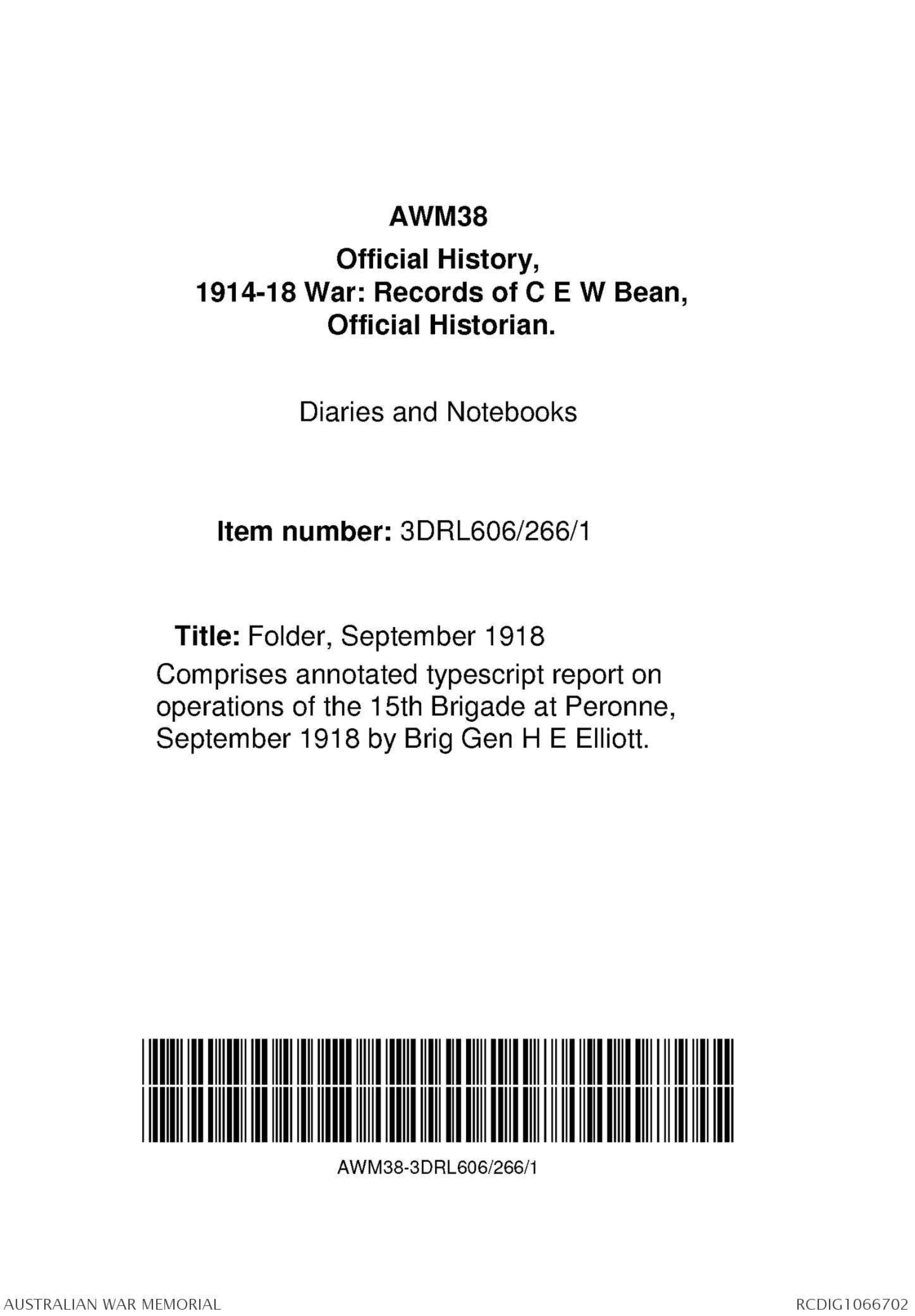
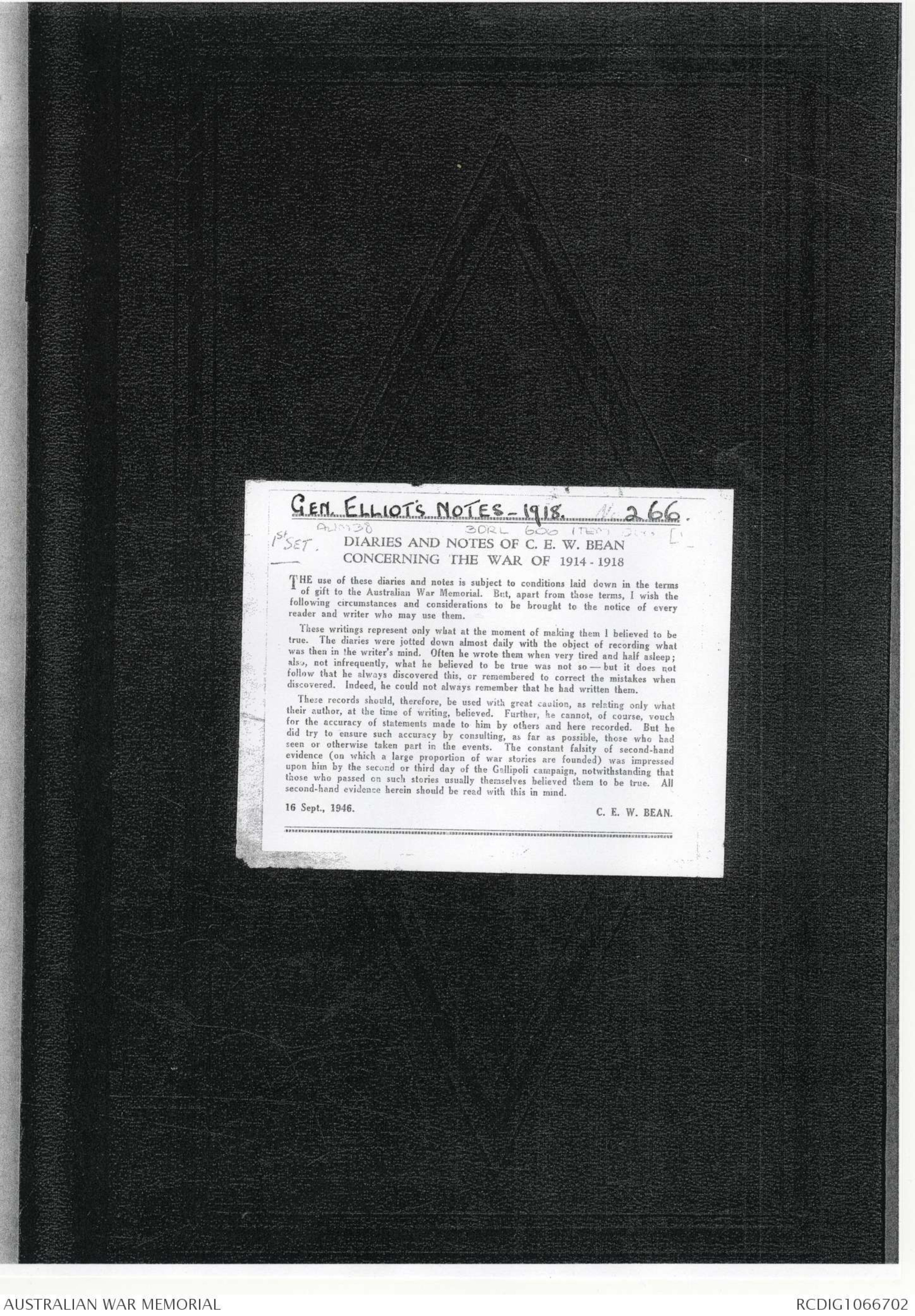


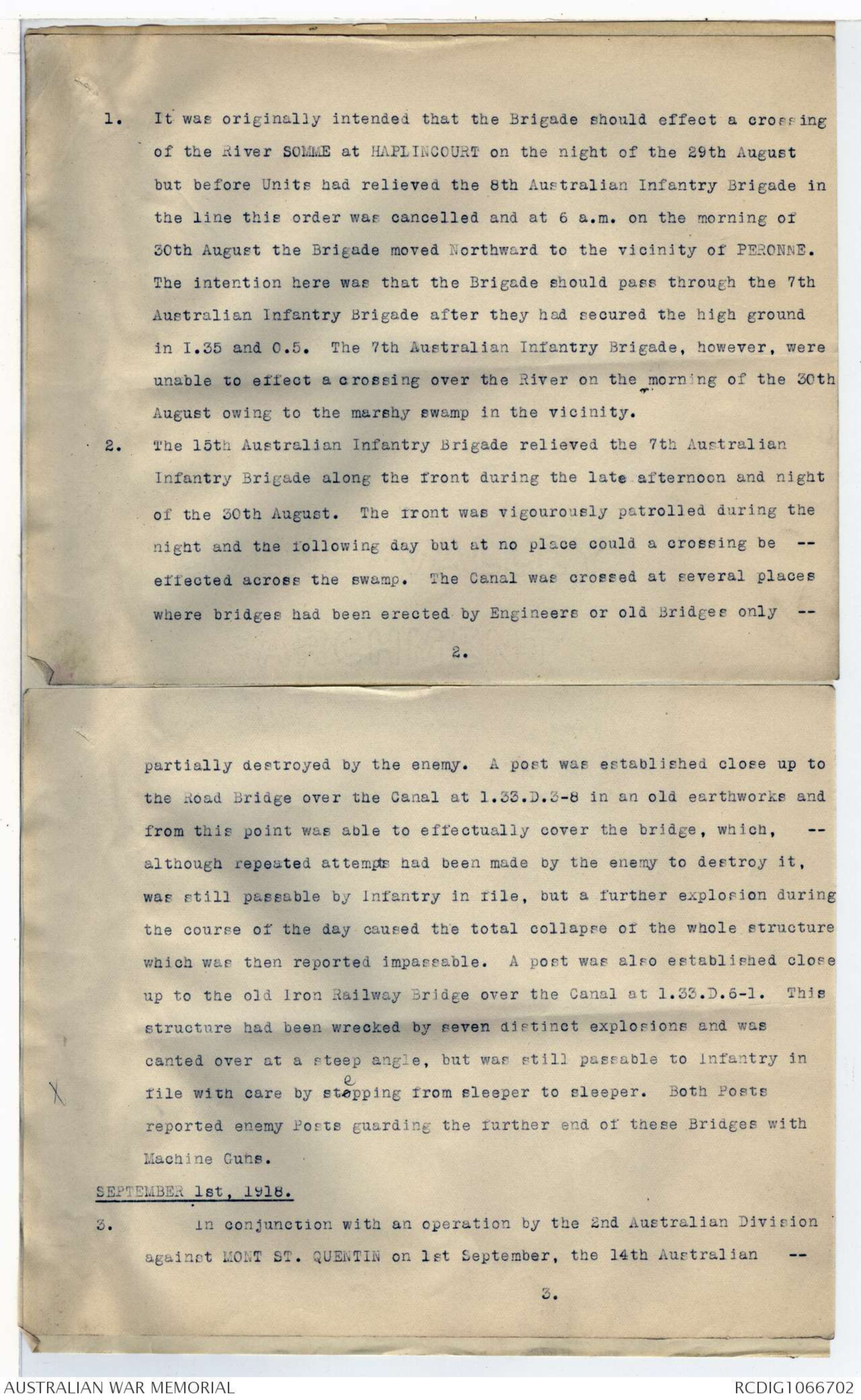
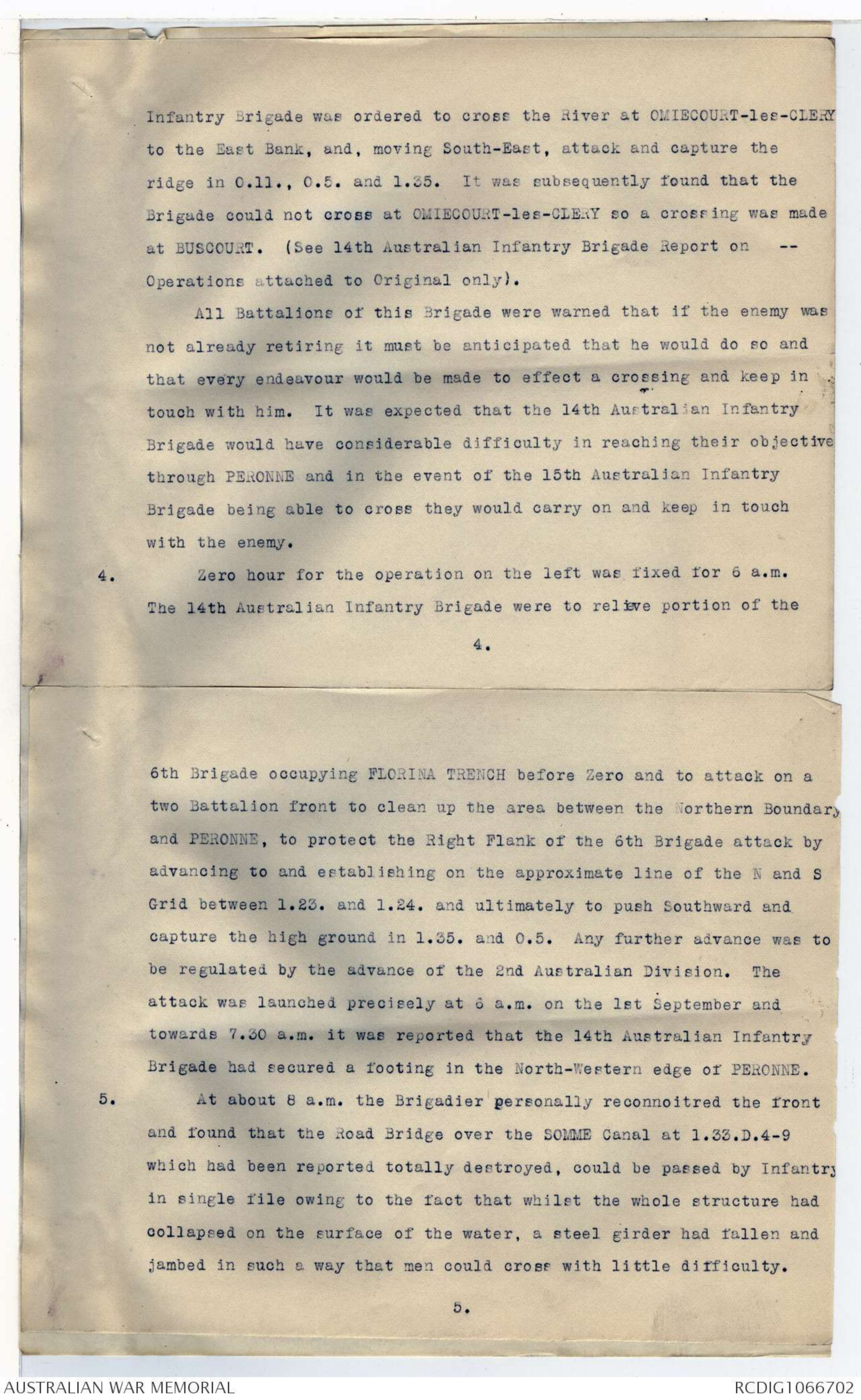



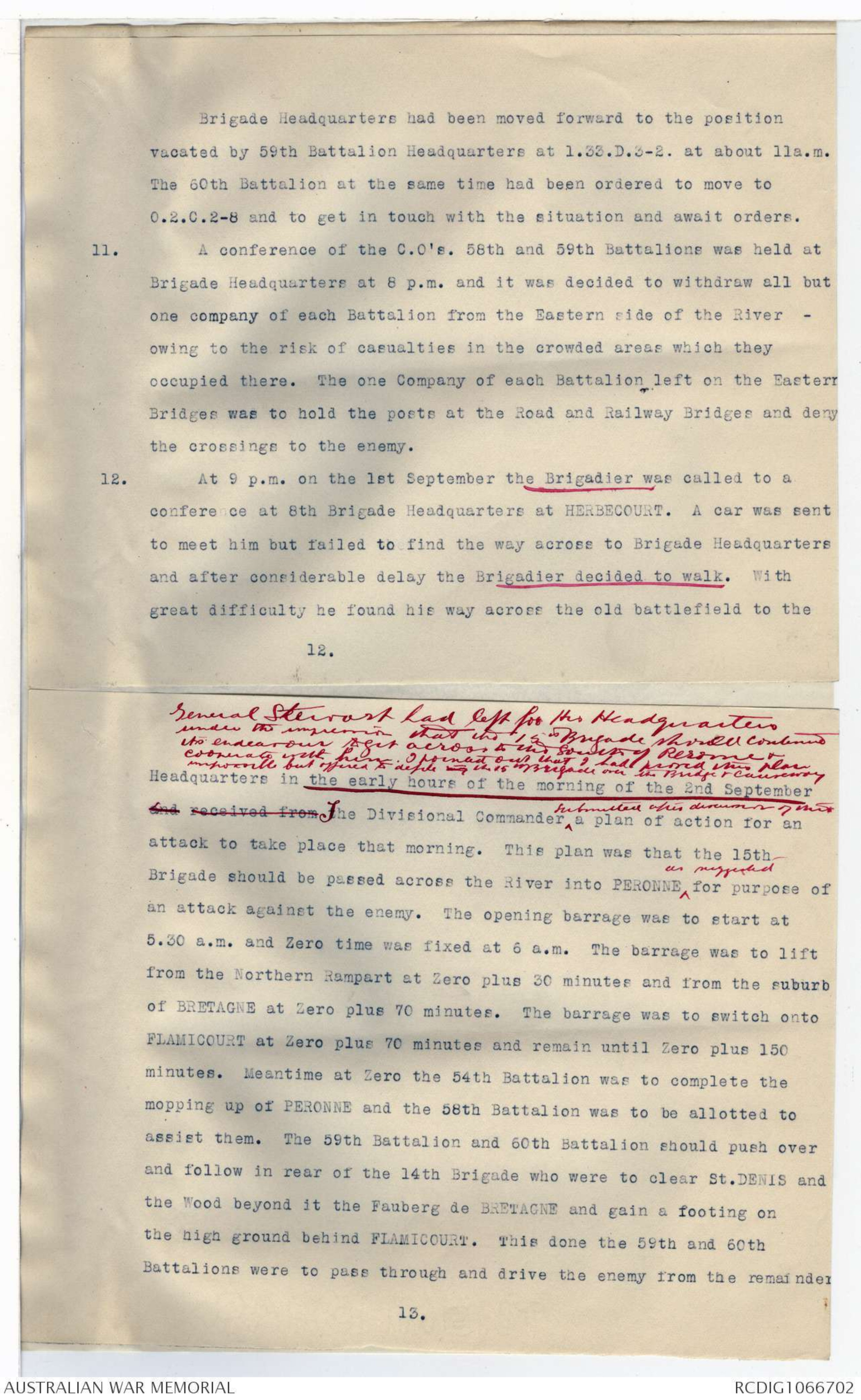
AWM38
Official History,
1914-18: Records of C E W Bean,
Official Historian.
Diaries and Notebooks
Item number: 3DRL606/266/1
Title: Folder, September 1918
Comprises annotated typescript report on
operations of the 15th Brigade at Peronne,
September 1918 by Brig Gen H E Elliott.
AWM38-3DRL606/266/1
GEN ELLIOT'S NOTES - 1918. No. 266
AWM38 3DRL 606 ITEM 266 [1]
1ST SET DIARIES AND NOTES OF C. E. W. BEAN
CONCERNING THE WAR OF 1914 - 1918
THE use of these diaries and notes is subject to conditions laid down in the terms
of gift to the Australian War Memorial. But, apart from these terms, I wish the
following circumstances and considerations to be brought to the notice of every
reader and writer who may use them.
These writings represent only what at the moment of making them I believed to be
true. The diaries were jotted down almost daily with the object of recording what
was then in the writer's mind. Often he wrote them when very tired and half asleep ;
also, not infrequently, what he believed to be true was not so — but it does not
follow that he always discovered this, or remembered to correct the mistakes when
discovered. Indeed, he could not always remember that he had written them.
These records should, therefore, be used with great caution, as relating only what
their author, at the time of writing, believed. Further, he cannot, of course, vouch
for the accuracy of statements made to him by others and here recorded. But he
did try to ensure such accuracy by consulting, as far as possible, those who had
seen or otherwise taken part in the events. The constant falsity of second-hand
evidence (on which a large proportion of war stories are founded) was impressed
upon him by the second or third day of the Gallipoli campaign, notwithstanding that
those who passed on such stories usually themselves believed them to be true. All
second-hand evidence herein should be read with this in mind.
16 Sept., 1946. C. E. W. BEAN.
Diagram - see original document
-1-
REPORT ON OPERATIONS.
as undertaken by
15th AUSTRALIAN INFANTRY BRIGADE.
near PERONNE
September 1st to 5th 1918 inclusive.
ORDER OF BATTLE, 15th AUSTRALIAN INFANTRY BRIGADE
Brigade Commander: Brig.-General H.E.Elliott C.B.,C.M.G.,D.S.O. D.C.M.
57th Battalion Lieut.Col. C.A.Denehy, D.S.O.
58th Battalion Major H.D.G.Ferres, M.C. (in the absence of
Lieut.Col. C.V. Watson on leave).
59th Battalion Lieut.Col.J.J. Scanlan, D.S.O.
60th Battalion Major T. Kerr, M.C. (in the absence of Lieut.
Col. H.T.C. Layh, D.S.O. on leave).
15th A.L.T.H.B. Captain J.H. McColl.
ATTACHED :
25th Machine Gun Coy. Capt. J.J.Saunders
15th Field Coy. A.E. Major H.Greenaway, D.S.O.
Bearer Sub-Division
15th Field Ambulance Major F.B. Craig.
PRELIMINARY MOVES AND ARRANGEMENTS :
1. It was originally intended that the Brigade should effect a crossing
of the River SOMME at HAPLINCOURT on the night of the 29th August
but before Units had relieved the 8th Australian Infantry Brigade in
the line this order was cancelled and at 6 a.m. on the morning of
30th August the Brigade moved further Northward to the vicinity of PERONNE.
The intention here was that the Brigade should pass through the 7th
Australian Infantry Brigade after they had secured the high ground
in I.35 and 0.5. The 7th Australian Infantry Brigade, however, were
unable to effect a crossing over the River on the morning of the 30th
August owing to the marshy swamp in the vicinity.
2. The 15th Australian Infantry Brigade relieved the 7th Australian
Infantry Brigade along the front during the late afternoon and night
of the 30th August. The front was vigourously patrolled during the
night and the following day but at no place could a crossing be --
effected across the swamp. The Canal was crossed at several places
where bridges had been erected by Engineers or old Bridges only --
2.
partially destroyed by the enemy. A post was established close up to
the Road Bridge over the Canal at 1.33.D.3-8 in an old earthworks and
from this point was able to effectually cover the bridge, which, --
although repeated attempts had been made by the enemy to destroy it,
was still passable by infantry in file, but a further explosion during
the course of the day caused the total collapse of the whole structure
which was then reported impassable. A post was also established close
up to the old Iron Railway Bridge over the Canal at 1.33.D.6-1. This
structure had been wrecked by seven distinct explosions and was
canted over at a steep angle, but was still passable to Infantry in
file with care by stoepping from sleeper to sleeper. Both Posts
reported enemy Posts guarding the further end of these Bridges with
Machine Guns.
SEPTEMBER 1st, 1918.
3. In conjunction with an operation by the 2nd Australian Division
against MONT ST. QUENTIN on 1st September, the 14th Australian --
3.
Infantry Brigade was ordered to cross the River at OMIECOURT-les-CLERY
to the East Bank, and, moving South-East, attack and capture the
ridge in 0.11., 0.5. and 1.35. It was subsequently found that the
Brigade could not cross at OMIECOURT-les-CLERY so a crossing was made
at BUSCOURT. (See 14th Australian Infantry Brigade Report on --
Operations attached to Original only).
All Battalions of this Brigade were warned that if the enemy was
not already retiring it must be anticipated that he would do so and
that every endeavour would be made to effect a crossing and keep in
touch with him. It was expected that the 14th Australian Infantry
Brigade would have considerable difficulty in reaching their objective
through PERONNE and in the event of the 15th Australian Infantry
Brigade being able to cross they would carry on and keep in touch
with the enemy.
4. Zero hour for the operation on the left was fixed for 6 a.m.
The 14th Australian Infantry Brigade were to relieve portion of the
4.
6th Brigade occupying FLORINA TRENCH before Zero and the attack on a
two Battalion front to clean up the area between the Northern Boundary
and PERONNE, to protect the Right Flank of the 6th Brigade attack by
advancing to and establishing on the approximate line of the N and S
Grid between 1.23. and 1.24. and ultimately to push Southward and
capture the high ground in 1.35. and 0.5. Any further advance was to
be regulated by the advance of the 2nd Australian Division. The
attack was launched at precisely at 6 a.m. on the 1st September and
towards 7.30 a.m. it was reported that the 14th Australian Infantry
Brigade had secured a footing in the North-Western edge of PERONNE.
5. At about 8 a.m. the Brigadier personally reconnoitred the front
and found that the Road Bridge over the SOMME Canal at 1.33.D.4-9
which had been reported totally destroyed, could be passed by Infantry
in single file owing to the fact that whilst the whole structure had
collapsed on the surface of the water, a steel girder had fallen and
jambed in such a way that men could cross with little difficulty.
5.
The Brigadier crossed without opposition but was fired on by
an enemy machine gun from the vicinity of the Railway Line on gaining
the crest of an old earthwork on the opposite bank. He immediately
directed the platoon of the 59th Battalion who held the post guarding
the Bridge on the West side to move at once and establish a post on
the opposite side, which was done. He then instructed the C.O.'s of
the 58th and 59th Battalions, to remove their Battalions, (the 58th
by the Road Bridge and the 59th by the Railway Bridge), to exploit the situation.
6. At 9.30 a.m. men of the 58th and 59th Battalions were fully
engaged in this operation and it was only now that the great difficulties
in the way stood revealed. The City of PERONNE proper stands
at the junction of the River SOMME and the River COLOGNE. Both
Rivers are the same in character. They meander through the wide marshy
valleys cutting narrow and deep channels here and there in the maze
of reeds and swamp which cover the whole bottom of the Valley. From
6.
the edges of the marsh the hills on either side rise sharply, in
places precipitously. The marsh area in the case of the SOMME varies
from 500 to 1,000 yards in width. It comprises within the area,
firstly the SOMME Canal, which runs entirely on its Western side
where the course is Northwards and on its Southern edge where the
Valley turns Westwards; secondly, the old channel of the SOMME RIVER
itself, and in most cases a third stream or Anabranch of the River
which latter joins the River COLOGNE within the city and a couple of
hundred yards above, the confluence of the latter with/the River
SOMME. The COLOGNE Valley is from 200 to 500 yards wide with one
main channel. The City of PERONNE proper extends along the right
bank of the River COLOGNE from its junction with the River SOMME
Northwards. On the high ground on the opposite bank of the COLOGNE
River and extending over a similar area is the village of FLAMICOURT
On this bank also close to the marsh is the PERONNE Railway Station
and Yard. A causeway has been built across the marsh from the
7.
Railway Station into PERONNE. In the centre of this causeway a
bridge spans the COLOGNE River. This Bridge had been destroyed by
explosives but, as in other cases, a single plank remained giving
a precarious foothold. From the Western Bank of the SOMME from which
the 15th Brigade was attempting to gain the City there runs two causeways
across the marsh. The one on the right carries the double tracked
Railway and loads into the Railway Station, which, as we have seen,
is in FLAMICOURT, and the other, the main road, which leads directly
into PERONNE itself.
7. During the preliminary reconnaissances four additional possible
crossing places over the marsh for Infantry were discovered. Two
above the Railway at 1.33.A.7-1. and 1.33.A.4-1. Two below the Main
Road Bridge at 0.3.B7-9. and 0.3.D.3-1. In each case however it
was found that the enemy had destroyed the bridges, had encumbered the
paths with barbed wire entanglements, and had these covered by Machine
Guns. All endeavours by patrols to effect a crossing found the enemy
8.
very alert and brought heavy Machine Gun Fire and the patrols often
suffered heavy loss.
8. The 59th Battalion pushed scouts out under Lieut. G.L.PENTREATH
M.C., to feel their way along the Railway. This patrol crossed the
Railway Bridge over the Canal without attracting attention, and,
followed by the leading Company, commenced to work towards the Station
They discovered and captured an enemy post who were guarding the
partially destroyed wooden bridge over the SOMME River, Lieut.
PENTREATH having shot dead the Officer in charge who attempted to
resist. Other charges intended to complete the destruction of this
Bridge, were found already laid and fused and were removed. This
Bridge also was made good and the advance continued until a further
wooden bridge, also partially destroyed, was found. The approach to
this was covered by rolls of barbed concertina wire and swept by
MachineGun Fire from the Station Yard. There was practically no
cover as the embankment or causeway here sinks almost to the level
9.
of the marsh and all further progress in this direction was barred.
9. Meantime the 58th Battalion had sent forward scouts along the causeway
leading into PERONNE. This is bordered with a row of ruined
houses forming the ___________ Faubourg de Paris.
They found a partially destroyed wooden bridge over the SOMME River
at 1.33.A.85.95. but the Twin bridges over the COLOGNE River at
1.33.A.95-95 were found to be intact and junction was effected with
men of the 14th Brigade (54th Battalion) within the City. It was then
found that further progress was exceptionally difficult. Machine Gun
Fire from the Railway Station swept all approaches to the Causeway
leading to it. The 54th Battalion had meantime cleared the suburb
of RADEGONDE and made their way into the Town from the North West,
seizing the Citadel and its garrison in spite of the huge ditch and
its formidable ramparts which still surrounded it; but circumvented
as they were by the ditch and marsh on either flank, and with every
street leading Northwards swept by Machine Gun fire from the Northern
10.
Ramparts (which the enemy still held) it was found impossible, despite
every effort, to make further headway.
At 11.30 a.m. the 58th and 59th Battalions each had two companies
across the River.
10. It was decided to bombard FLAMICOURT with a creeping barrage
at 4.30 p.m. to dislodge the Machine Guns but this proved ineffectual.
The Railway Station was a strongly built two storey brick building.
The enemy had, by using stool rails and concrete formed the ground
floor into a huge pill box fort which resisted with ease a heavy
bombardment with 6" Howitzers with splendid observation. Many direct
hits speedily reduced the top floors to ruins but had no effect on
the Machine Gunners below.
The Brigadier spoke to the Divisional Commander and explained
the situation, viz: that the enemy was holding the North-Eastern
third of PERONNE, effectually barring our advance and that the --
Railway causeway and Road from PERONNE to the Station were impassable
owing to the Machine Gun fire.
11.
Brigade Headquarters had been moved forward to the position
vacated by the 59th Battalion Headquarters at 1.33.D.3-2. at about 11a.m.
The 60th Battalion at the same time had been ordered to move to
0.2.C.2-8 and to get in touch with the situation and await orders.
11. A conference of the C.O.'s. 58th and 59th Battalions was held at
Brigade Headquarters at 8 p.m. and it was decided to withdraw all but
one company of each Battalion from the Eastern side of the River -
owing to the risk of casualties in the crowded areas which they
occupied there. The one Company of each Battalion left on the Eastern
Bridges was to hold the posts at the Road and Railway Bridges and deny
the crossings to the enemy.
12. At 9 p.m. on the 1st September the Brigadier was called to a
conference at the 8th Brigade Headquarters at HERBECOURT. A car was sent
to meet him but failed to find the way across to Brigade Headquarters
and after considerable delay the Brigadier decided to walk. With
great difficulty he found his way across the old battlefield to the
12.
[*General Stewart had left for the Headquarters
under the impression that the 15th Brigade should continue
its endeavour to get across to the south of Peronne &
cooperate with him. I pointed out that I had found this plan
impossible but offered to defile my the 15th Brigade over the Bridge & Causeway.*]
Headquarters in the early hours of the morning of the 2nd Septemberand received from The Divisional Commander ^submitted after discussion of this a plan of action for an
attack to take place that morning. This plan was that the 15th
Brigade should be passed across the River into PERONNE ^as suggested for purpose of
an attack against the enemy. The opening barrage was to start at
5.30 a.m. and Zero time was fixed at 6 a.m. The barrage was to lift
from the Northern Rampart at Zero plus 30 minutes and from the suburb
of BRETAGNE at Zero plus 70 minutes. The barrage was to switch onto
FLAMICOURT at Zero plus 70 minutes and remain until Zero plus 150
minutes. Meantime at Zero the 54th Battalion was to complete the
mopping up of PERONNE and the 58th Battalion was to be allotted to
assist them. The 59th Battalion and 60th Battalion should push over
and follow the rear of the 14th Brigade who were to clear St.DENIS and
the Wood beyond it the Fauberg de BRETAGNE and gain a footing on
the high ground behind FLAMICOURT. This done the 59th and 60th
Battalions were to pass through and drive the enemy from the remainder
13.
 Transcriber 30168
Transcriber 30168This transcription item is now locked to you for editing. To release the lock either Save your changes or Cancel.
This lock will be automatically released after 60 minutes of inactivity.